The Effects of Double-Step Homogenization on Precipitation Behavior of Al3Zr Dispersoids and Microstructural Evolution in 2196 Aluminum Alloy
Abstract
1. Introduction
2. Materials and Methods
3. Results
3.1. As-Cast Microstructure
3.2. Microstructural Evolution during First-Step Homogenization
3.3. Microstructural Evolution during Second-Step Homogenization
3.4. Precipitation Behavior of Al3Zr Dispersoids during Different Homogenization Processes
3.5. Precipitation of Al3Zr Dispersoids during Different Heating Rates
4. Discussions
4.1. Nucleation Model of Al3Zr Dispersoids
4.2. Homogenization Kinetic Analysis
5. Conclusions
- During the second-step homogenization, regardless of the different first-step homogenization temperatures, most of the microsegregation is eliminated, and the θ’ precipitates formed during first-step homogenization are dissolved. The different first-step homogenization temperatures can result in a different distribution of Al3Zr dispersoids after a second-step homogenization at 520 °C. The optimized homogenization process of 400 °C/10 h + 520 °C/24 h can effectively dissolve the primary phases and refine the distribution of Al3Zr dispersoids.
- Decreasing the heating rate of the homogenization process can greatly increase the number density of the Al3Zr dispersoids. However, regulation of the heating rate could not improve the uniformity of the Al3Zr dispersoids.
- The corresponding precipitation of the Al3Zr dispersoids model and dissolution kinetics of the primary phases have been developed for the homogenization process of the 2196 alloy, which corresponds well with these experimental results.
Author Contributions
Funding
Data Availability Statement
Conflicts of Interest
References
- Abd El-Aty, A.; Xu, Y.; Guo, X.; Zhang, S.; Ma, Y.; Chen, D. Strengthening mechanisms, deformation behavior, and anisotropic mechanical properties of Al-Li alloys: A review. J. Adv. Res. 2018, 10, 49–67. [Google Scholar] [CrossRef]
- Yu, X.; Dai, H.; Li, Z.; Sun, J.; Zhao, J.; Li, C.; Liu, W. Improved Recrystallization Resistance of Al-Cu-Li-Zr Alloy through Ce Addition. Metals 2018, 8, 1035. [Google Scholar] [CrossRef]
- Ta, N.; Bilal, M.U.; Hausler, I.; Saxena, A.; Lin, Y.Y.; Schleifer, F.; Fleck, M.; Glatzel, U.; Skrotzki, B.; Darvishi Kamachali, R. Simulation of the θ′ precipitation process with interfacial anisotropy effects in Al-Cu alloys. Materials 2021, 14, 1280. [Google Scholar] [CrossRef] [PubMed]
- Chen, X.; Ma, X.; Xi, H.; Zhao, G.; Wang, Y.; Xu, X. Effects of heat treatment on the microstructure and mechanical properties of extruded 2196 Al-Cu-Li alloy. Mater. Des. 2020, 192, 108746. [Google Scholar] [CrossRef]
- Xu, X.; Ma, X.; Yu, S.; Zhao, G.; Wang, Y.; Chen, X. Bonding mechanism and mechanical properties of 2196 Al-Cu-Li alloy joined by hot compression deformation. Mater. Charact. 2020, 167, 110486. [Google Scholar] [CrossRef]
- Chen, X.; Zhao, G.; Liu, G.; Sun, L.; Chen, L.; Zhang, C. Microstructure evolution and mechanical properties of 2196 Al-Li alloy in hot extrusion process. J. Mater. Process. Technol. 2020, 275, 116348. [Google Scholar] [CrossRef]
- Ning, Y.; Zhang, X.; Huang, Y.; Ding, L.; Lei, X.; Weng, Y.; Cao, L.; Zhang, K.; Jia, Z. The Effect of Thermomechanical Processing Sequence on the Dispersoid Distribution and Final Mechanical Properties of Spray-Formed Al-Cu-Li Alloy. Metals 2022, 12, 1893. [Google Scholar] [CrossRef]
- Lue, X.; Guo, E.; Rometsch, P.; Wang, L. Effect of one-step and two-step homogenization treatments on distribution of Al3Zr dispersoids in commercial AA7150 aluminium alloy. Trans. Nonferrous Met. Soc. China 2012, 22, 2645–2651. [Google Scholar] [CrossRef]
- Li, H.; Yu, W.; Wang, X.; Du, R.; You, W. Investigation on Microstructural Evolution and Properties of an Al-Cu-Li Alloy with Mg and Zn Microalloying during Homogenization. Metals 2018, 8, 1010. [Google Scholar] [CrossRef]
- Liu, Q.; Fan, G.; Tan, Z.; Li, Z.; Zhang, D.; Wang, J.; Zhang, H. Precipitation of Al3Zr by two-step homogenization and its effect on the recrystallization and mechanical property in 2195 Al-Cu-Li alloys. Mater. Sci. Eng. A 2021, 821, 141637. [Google Scholar] [CrossRef]
- Jia, Z.; Hu, G.; Forbord, B.; Solberg, J.K. Effect of homogenization and alloying elements on recrystallization resistance of Al-Zr-Mn alloys. Mater. Sci. Eng. A 2007, 444, 284–290. [Google Scholar] [CrossRef]
- Knipling, K.E.; Dunand, D.C.; Seidman, D.N. Nucleation and precipitation strengthening in dilute Al-Ti and Al-Zr alloys. Metall. Mater. Trans. A 2007, 38, 2552–2563. [Google Scholar] [CrossRef]
- Tsivoulas, D.; Ronson, J.D.; Sigli, C.; Prangnell, P.B. Interactions between zirconium and manganese dispersoid-forming elements on their combined addition in Al-Cu-Li alloys. Acta Mater. 2012, 60, 5245–5259. [Google Scholar] [CrossRef]
- Honaramooz, M.T.; Morak, R.; Pogatscher, S.; Fritz-Popovski, G.; Kremmer, T.M.; Meisel, T.C.; Österreicher, J.A.; Arnoldt, A.; Paris, O. Characterization of Zr-Containing Dispersoids in Al–Zn–Mg–Cu Alloys by Small-Angle Scattering. Materials 2023, 16, 1213. [Google Scholar] [CrossRef] [PubMed]
- Robson, J.D. Optimizing the homogenization of zirconium containing commercial aluminium alloys using a novel process model. Mater. Sci. Eng. A 2002, 338, 219–229. [Google Scholar] [CrossRef]
- Guo, Y.; Li, J.; Lu, D.; Deng, S.; Zeng, G.; Ma, Y.; You, W.; Chen, Y.; Zhang, X.; Zhang, R. Characterization of Al3Zr precipitation via double-step homogenization and recrystallization behavior after subsequent deformation in 2195 Al-Li alloy. Mater. Charact. 2021, 182, 111549. [Google Scholar] [CrossRef]
- Pourkia, N.; Emamy, M.; Farhangii, H.; Ebrahimi, S.S. The effect of Ti and Zr elements and cooling rate on the microstructure and tensile properties of a new developed super high-strength aluminum alloy. Mater. Sci. Eng. A 2010, 527, 5318–5325. [Google Scholar] [CrossRef]
- Robson, J.D.; Prangnell, P.B. Dispersoid precipitation and process modelling in zirconium containing commercial aluminium alloys. Acta Mater. 2001, 49, 599–613. [Google Scholar] [CrossRef]
- Li, S.; Wei, B.; Yu, C.; Li, Y.; Xu, G.; Li, Y. Evolution of microstructure and properties during homogenization of the novel Al-Li alloy fabricated by electromagnetic oscillation twin-roll casting. J. Mater. Res. Technol. 2020, 9, 3304–3317. [Google Scholar] [CrossRef]
- Deng, Y.; Xu, J.; Chen, J.; Guo, X. Effect of double-step homogenization treatments on the microstructure and mechanical properties of Al-Cu-Li-Zr alloy. Mater. Sci. Eng. A 2020, 795, 139975. [Google Scholar] [CrossRef]
- Yang, S.; Shen, J.; Yan, X.; Li, X.; Zhang, F.; Sun, B. Homogenization treatment parameter optimization and microstructural evolution of Al-Cu-Li alloy. Rare Met. Mater. Eng. 2017, 46, 28–34. [Google Scholar]
- Wang, Y.; Ma, X.; Zhao, G.; Xu, X.; Chen, X.; Zhang, C. Microstructure evolution of spray deposited and as-cast 2195 Al-Li alloys during homogenization. J. Mater. Sci. Technol. 2021, 82, 161–178. [Google Scholar] [CrossRef]
- Wang, S.; Starink, M.J. Precipitates and intermetallic phases in precipitation hardening Al-Cu-Mg-(Li) based alloys. Int. Mater. Rev. 2005, 50, 193–215. [Google Scholar] [CrossRef]
- Li, J.; Ning, H.; Liu, D.; Zheng, Z. Alloying and micro-alloying in Al-Cu-Li series alloys. Chin. J. Nonferrous Met. 2021, 31, 258–279. [Google Scholar]
- Tsivoulas, D.; Robson, J.D. Heterogeneous Zr solute segregation and Al3Zr dispersoid distributions in Al-Cu-Li alloys. Acta Mater. 2015, 93, 73–86. [Google Scholar] [CrossRef]
- Khan, I.N.; Starink, M.J.; Yan, J. A model for precipitation kinetics and strengthening in Al-Cu-Mg alloys. Mater. Sci. Eng. A 2008, 472, 66–74. [Google Scholar] [CrossRef]
- Werenskiold, J.C.; Deschamps, A.; Brechet, Y. Characterization and modeling of precipitation kinetics in an Al-Zn-Mg alloy. Mater. Sci. Eng. A 2000, 293, 267–274. [Google Scholar] [CrossRef]
- Robson, J.D.; Prangnell, P.B. Modelling Al3Zr dispersoid precipitation in multicomponent aluminium alloys. Mater. Sci. Eng. A 2003, 352, 240–250. [Google Scholar] [CrossRef]
- Chen, R.; Xu, Q.; Guo, H.; Xia, Z.; Wu, Q.; Liu, B. Modeling the precipitation kinetics and tensile properties in Al-7Si-Mg cast aluminum alloys. Mater. Sci. Eng. A 2017, 685, 403–416. [Google Scholar] [CrossRef]
- Christian, J.W. The Theory of Transformations in Metals and Alloys; Newnes; Elsevier: Amsterdam, The Netherlands, 2002. [Google Scholar]
- Kamp, N.; Sullivan, A.; Tomaasi, R.; Robsonn, J.D. Modelling of heterogeneous precipitate distribution evolution during friction stir welding process. Acta Mater. 2006, 54, 2003–2014. [Google Scholar] [CrossRef]
- Ronson, J.D. A new model for prediction of dispersoid precipitation in aluminium alloys containing zirconium and scandium. Acta Mater. 2004, 52, 1409–1421. [Google Scholar] [CrossRef]
- Liu, X.; Pan, Q.; Fan, X.; He, Y.; Li, B.; Liang, W. Microstructural evolution of Al-Cu-Mg-Ag alloy during homogenization. J. Alloys Compd. 2009, 484, 790–794. [Google Scholar] [CrossRef]
- Zhang, F.; Shen, J.; Yan, X.; Sun, J.; Sun, X.; Wang, Y. Homogenization heat treatment of 2099 Al-Li alloy. Rare Met. 2014, 33, 28–36. [Google Scholar] [CrossRef]
- Ujihara, T.; Fujiwara, K.; Sazaki, G.; Usami, N.; Nakajima, K. New method for measurement of interdiffusion coefficient in high temperature solutions based on Fick’s first law. J. Cryst. Growth 2002, 241, 387–394. [Google Scholar] [CrossRef]
- Liu, G. Fundamentals of Metallurgy; Metallurgical Industry Press: Beijing, China, 1980; p. 283. [Google Scholar]

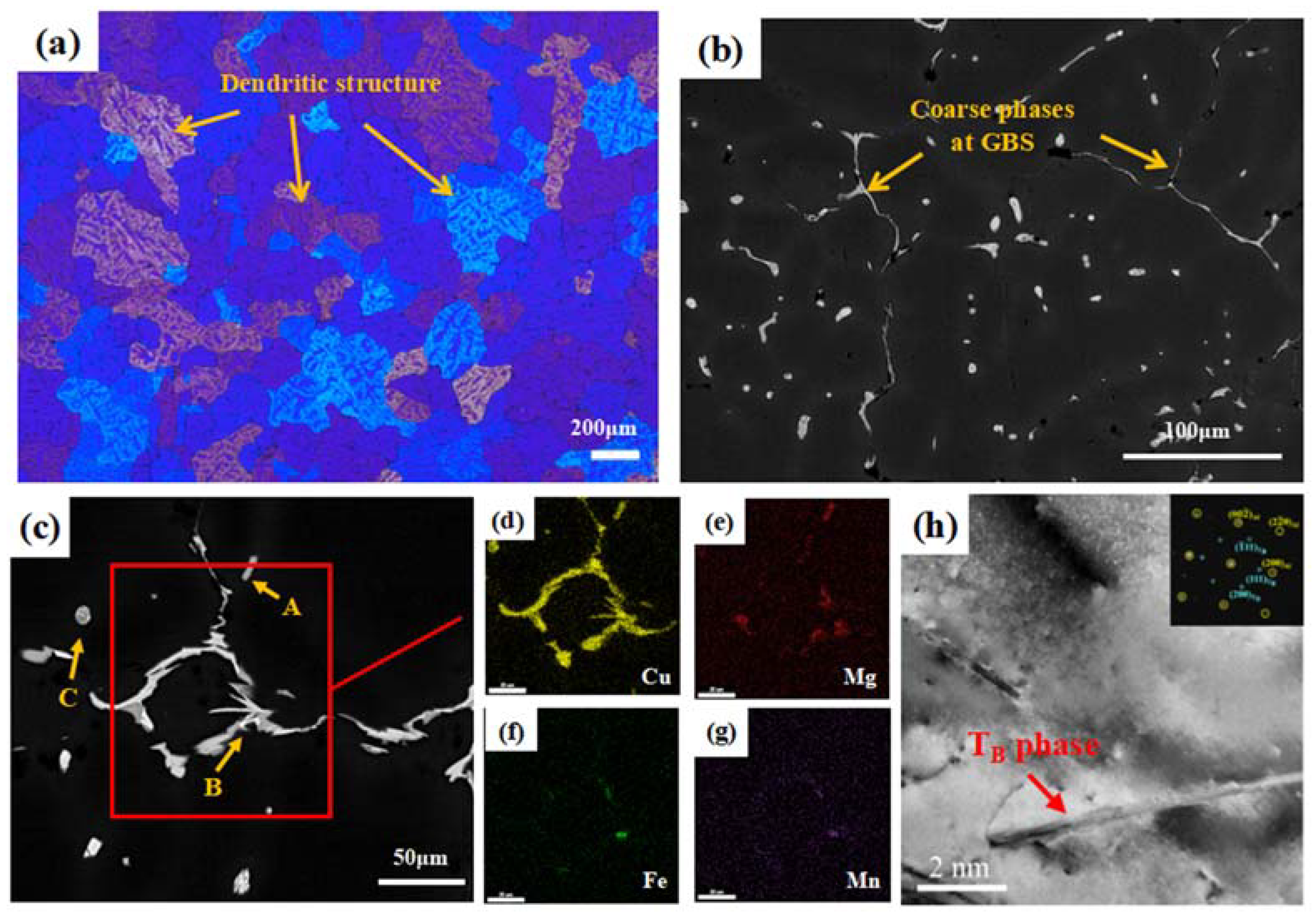

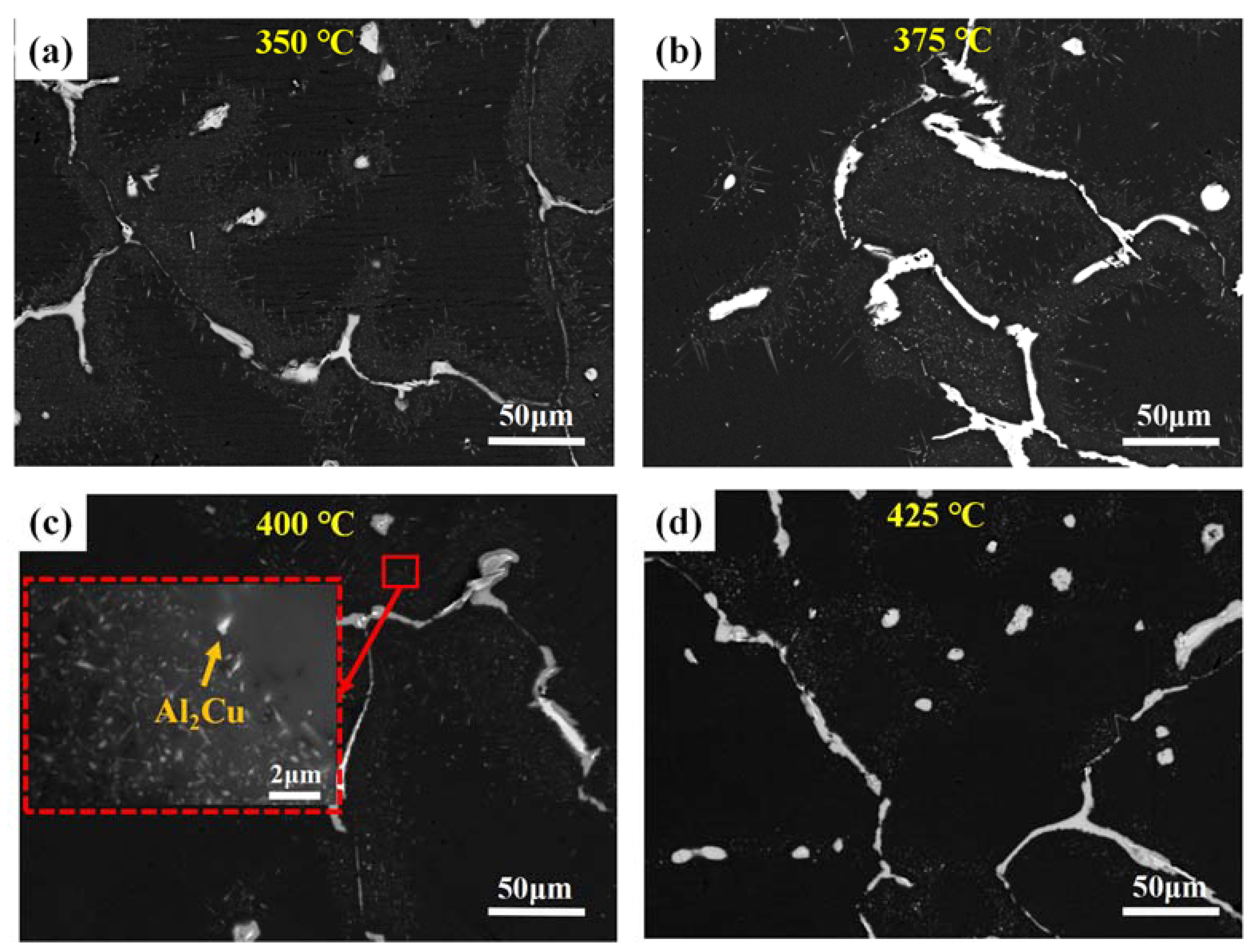
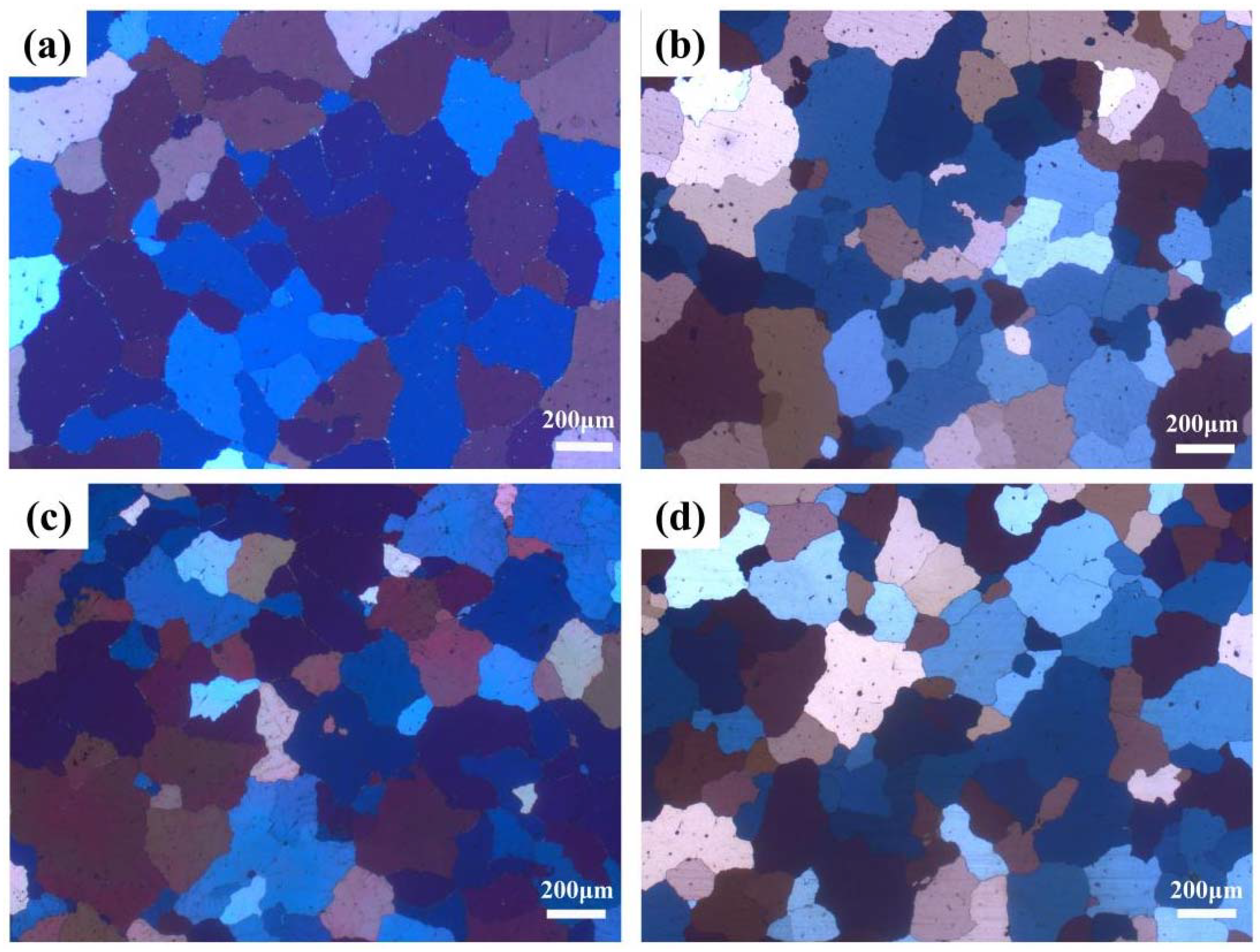
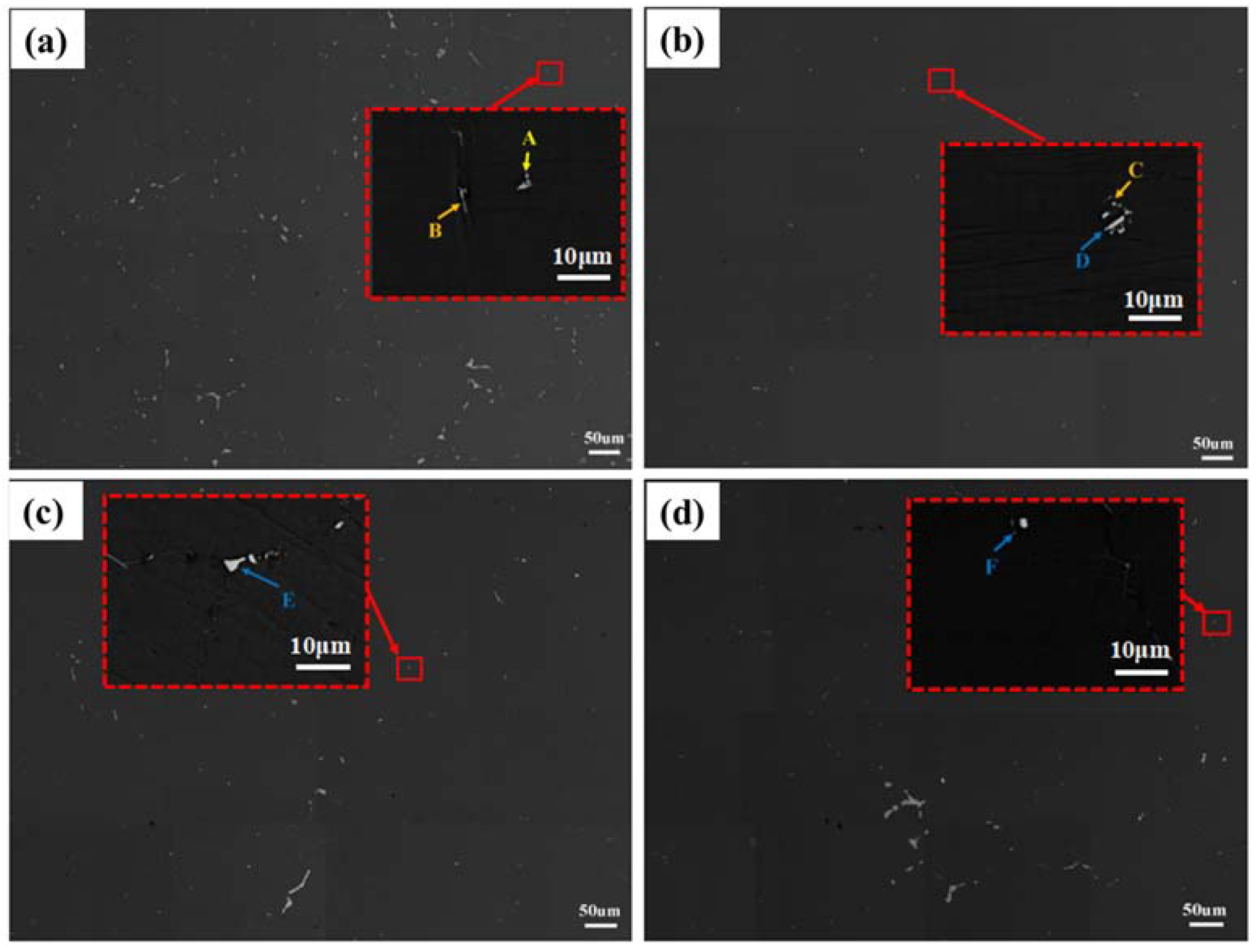
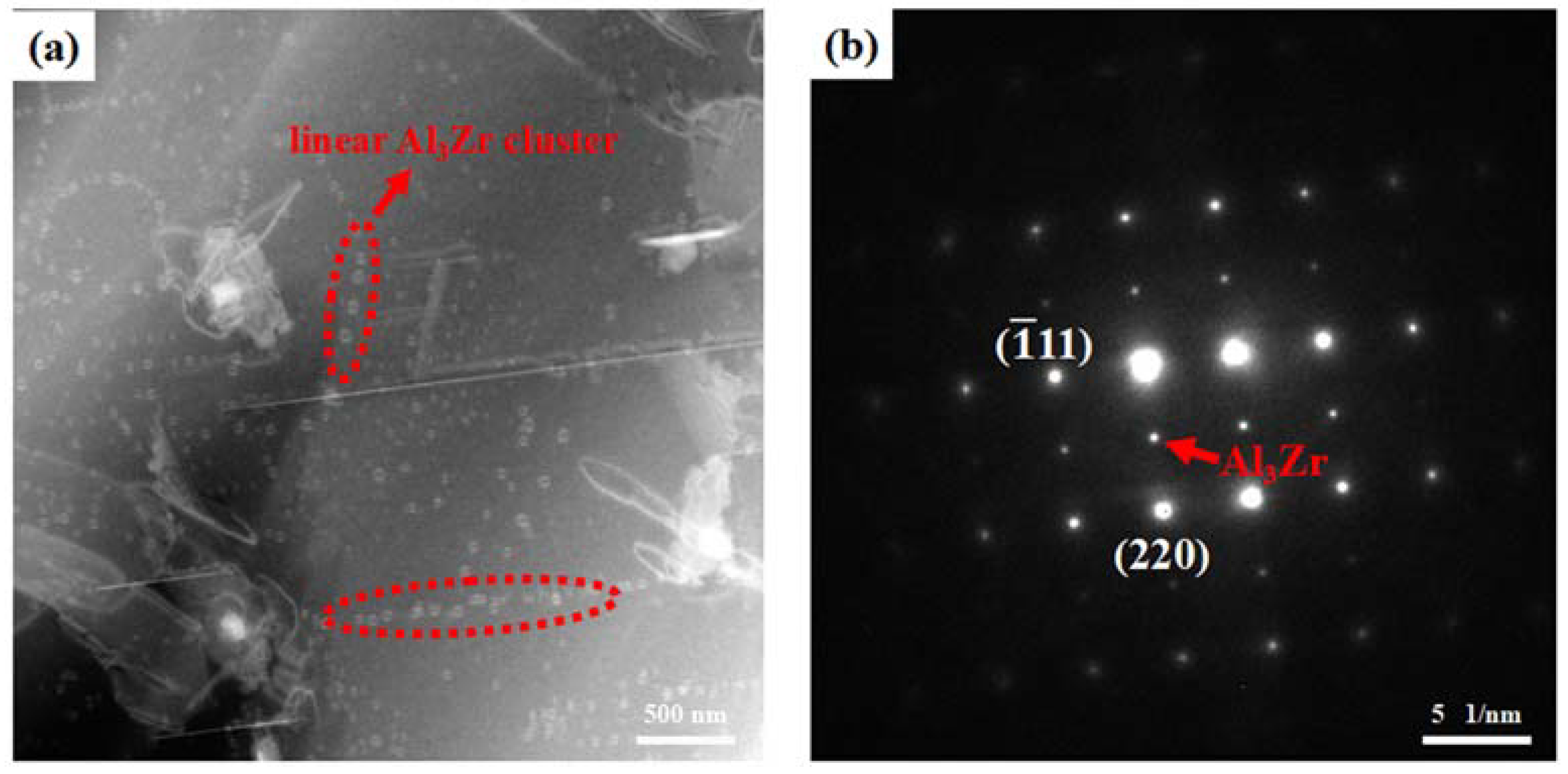

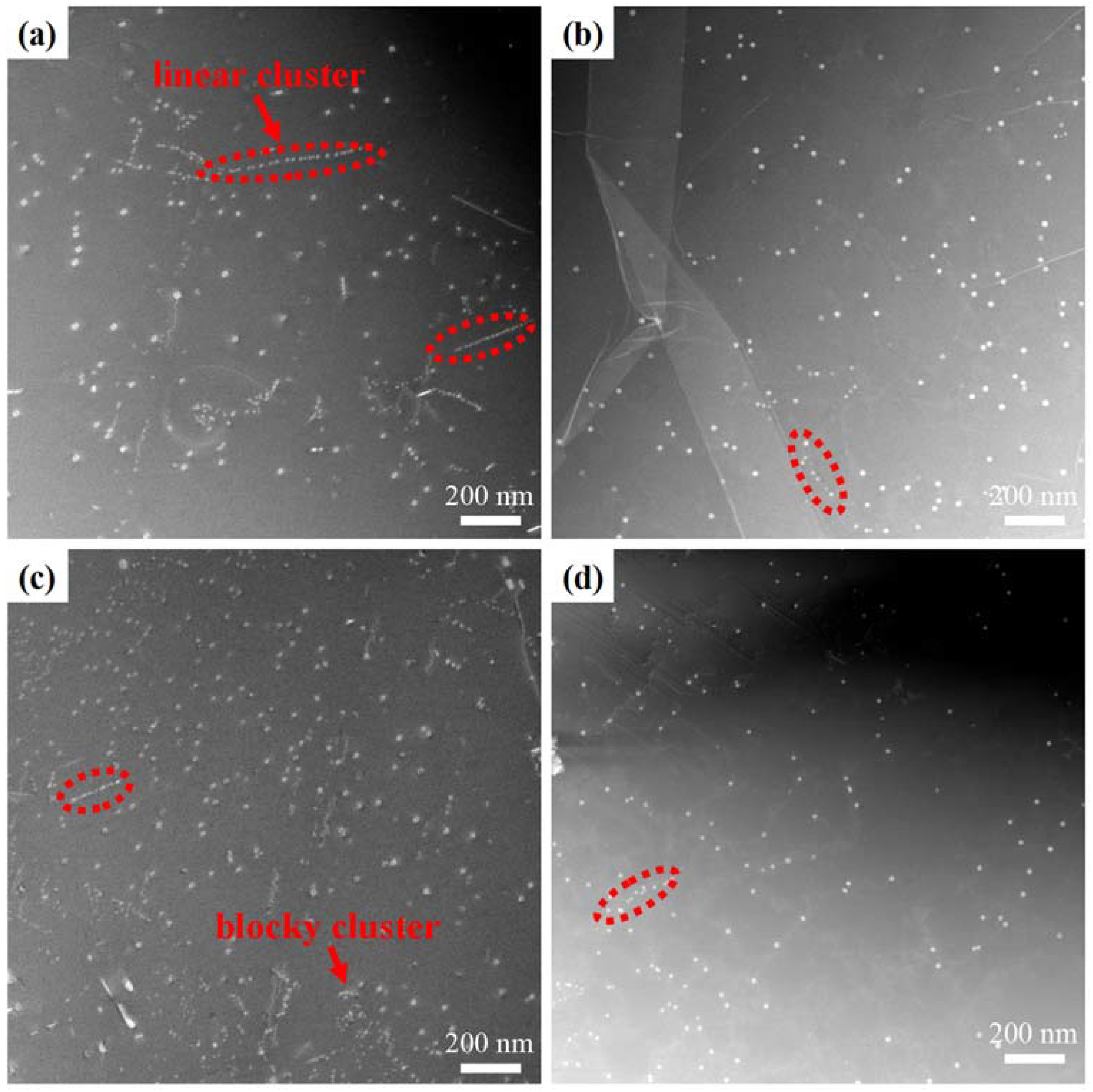
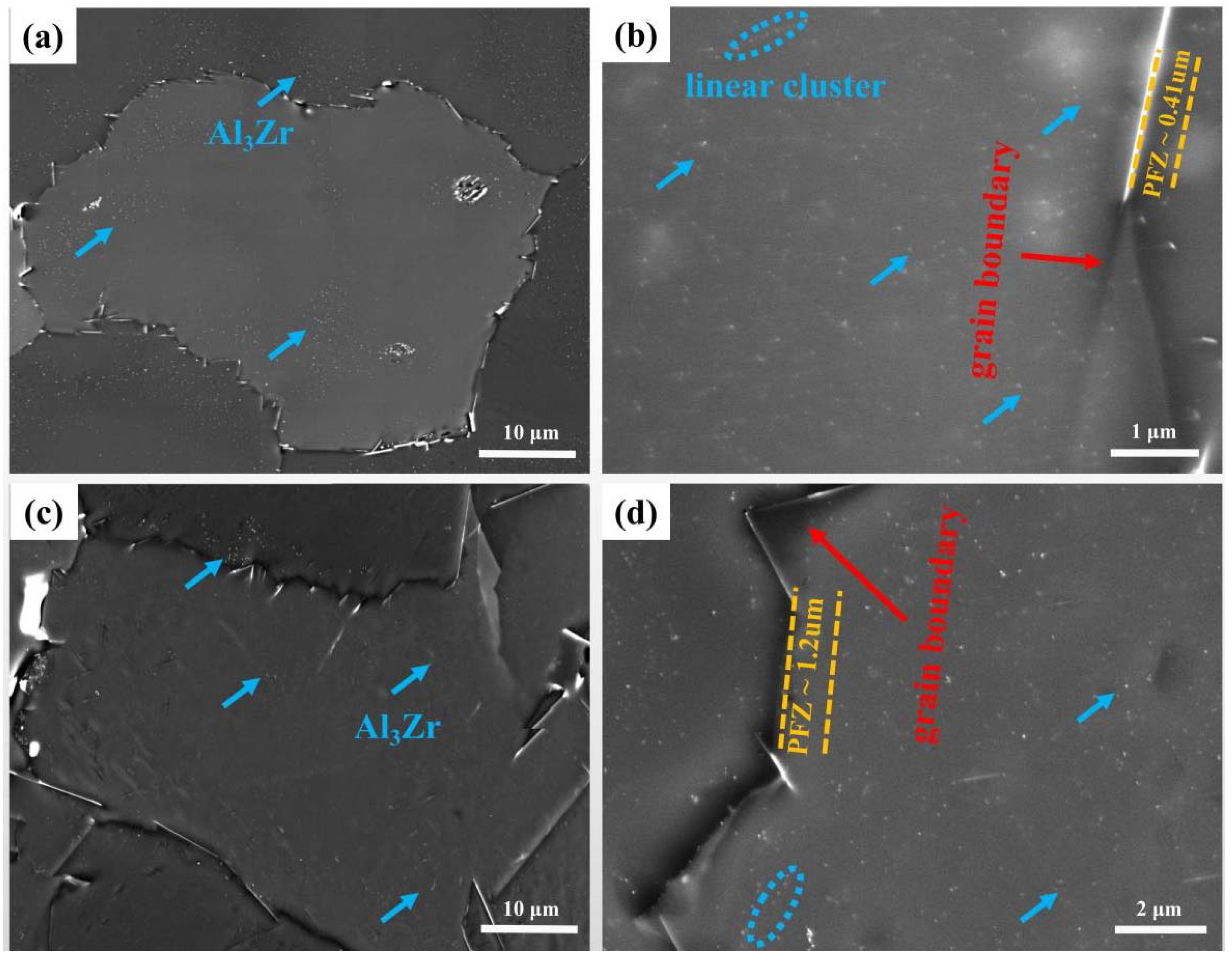
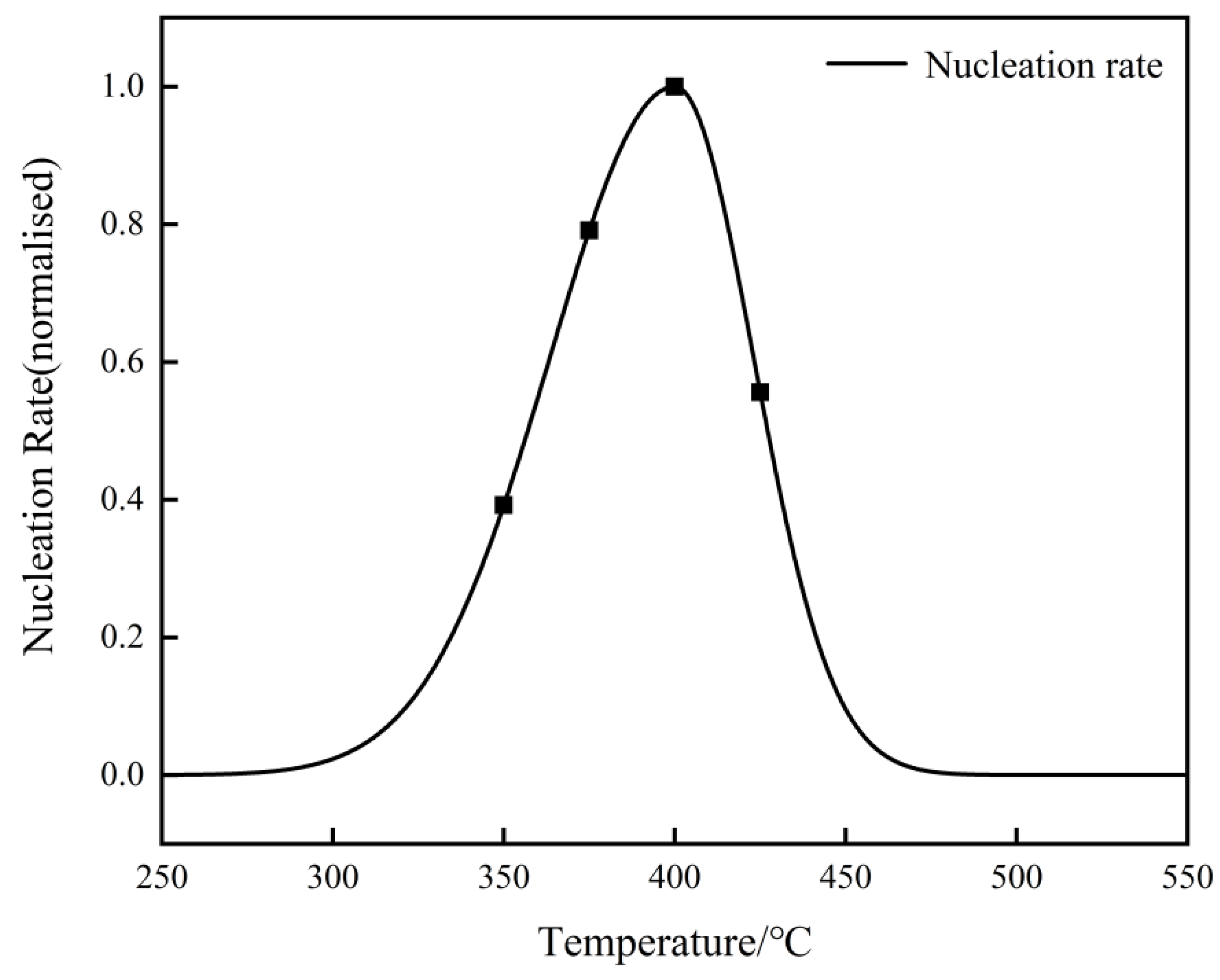
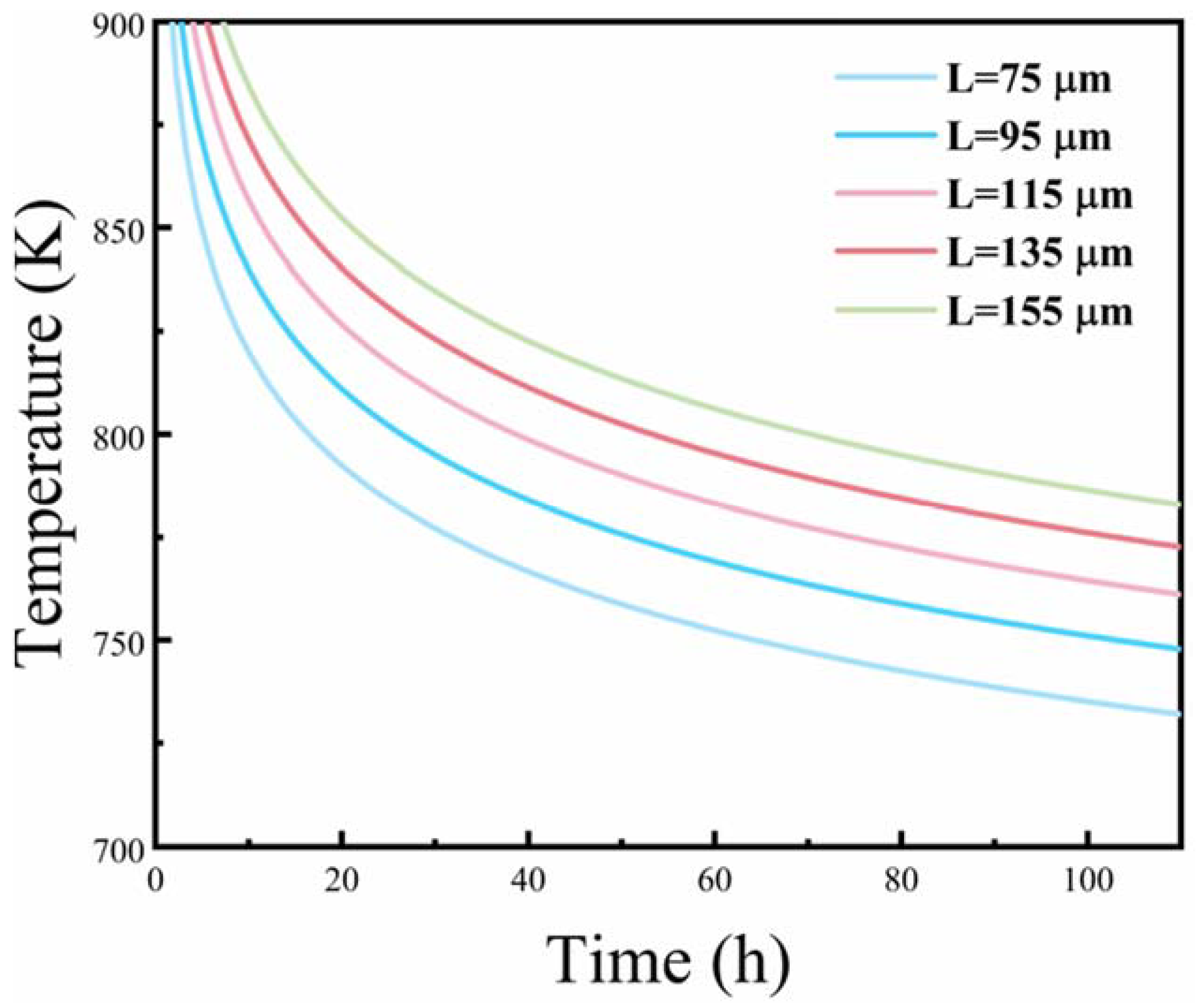
| Alloy | Cu | Li | Mg | Ag | Mn | Zn | Zr | Fe | Al |
|---|---|---|---|---|---|---|---|---|---|
| 2196 | 2.80 | 1.67 | 0.39 | 0.38 | 0.13 | 0.13 | 0.09 | 0.021 | Balance |
| Point | Al | Cu | Mg | Cr | Fe | Mn |
|---|---|---|---|---|---|---|
| A | 76.16 | 13.28 | 10.17 | 0.22 | 0.15 | 0.11 |
| B | 70.31 | 17.66 | 3.01 | 0.03 | 6.72 | 2.27 |
| C | 77.09 | 17.73 | 4.80 | 0.03 | 0.23 | 0.13 |
| Point | Al | Cu | Mg | Ag | Fe | Mn | Zn |
|---|---|---|---|---|---|---|---|
| A | 82.66 | 7.48 | 1.70 | 0.39 | 2.25 | 5.41 | 0.09 |
| B | 90.25 | 7.91 | 1.00 | 0.56 | 0.03 | 0.06 | 0.16 |
| C | 87.33 | 9.07 | 2.32 | 0.21 | 0.03 | 0.93 | 0.10 |
| D | 80.57 | 11.69 | 4.39 | 0.38 | 4.39 | 0.57 | 0.36 |
| E | 73.97 | 16.33 | 1.49 | 0.18 | 6.41 | 1.05 | 0.53 |
| F | 94.63 | 1.79 | 2.20 | 0.12 | 1.05 | 0.11 | 0.09 |
| Homogenization Parameters | r (nm) | Nv (μm−3) | fv (%) | fv/r (μm−1) |
|---|---|---|---|---|
| 350 °C/10 h + 520 °C/24 h | 18 | 9.3 | 0.48 | 0.267 |
| 375 °C/10 h + 520 °C/24 h | 14 | 9.7 | 0.32 | 0.229 |
| 400 °C/10 h + 520 °C/24 h | 11 | 12.1 | 0.61 | 0.554 |
| 425 °C/10 h + 520 °C/24 h | 13 | 7.7 | 0.39 | 0.3 |
Disclaimer/Publisher’s Note: The statements, opinions and data contained in all publications are solely those of the individual author(s) and contributor(s) and not of MDPI and/or the editor(s). MDPI and/or the editor(s) disclaim responsibility for any injury to people or property resulting from any ideas, methods, instructions or products referred to in the content. |
© 2023 by the authors. Licensee MDPI, Basel, Switzerland. This article is an open access article distributed under the terms and conditions of the Creative Commons Attribution (CC BY) license (https://creativecommons.org/licenses/by/4.0/).
Share and Cite
Zhou, H.; Ding, L.; Liu, M.; Zeng, Y.; Lei, X.; Weng, Y.; Wang, K.; Jia, Z. The Effects of Double-Step Homogenization on Precipitation Behavior of Al3Zr Dispersoids and Microstructural Evolution in 2196 Aluminum Alloy. Metals 2023, 13, 1018. https://doi.org/10.3390/met13061018
Zhou H, Ding L, Liu M, Zeng Y, Lei X, Weng Y, Wang K, Jia Z. The Effects of Double-Step Homogenization on Precipitation Behavior of Al3Zr Dispersoids and Microstructural Evolution in 2196 Aluminum Alloy. Metals. 2023; 13(6):1018. https://doi.org/10.3390/met13061018
Chicago/Turabian StyleZhou, Hongyu, Lipeng Ding, Manping Liu, Ying Zeng, Xiuchuan Lei, Yaoyao Weng, Kui Wang, and Zhihong Jia. 2023. "The Effects of Double-Step Homogenization on Precipitation Behavior of Al3Zr Dispersoids and Microstructural Evolution in 2196 Aluminum Alloy" Metals 13, no. 6: 1018. https://doi.org/10.3390/met13061018
APA StyleZhou, H., Ding, L., Liu, M., Zeng, Y., Lei, X., Weng, Y., Wang, K., & Jia, Z. (2023). The Effects of Double-Step Homogenization on Precipitation Behavior of Al3Zr Dispersoids and Microstructural Evolution in 2196 Aluminum Alloy. Metals, 13(6), 1018. https://doi.org/10.3390/met13061018






